Maybe your gaming laptop doesn’t have enough storage. Or you simply want an easy way to make your game library portable. An external SSD can fix both of these issues (and more) by providing an easy way to expand storage that you can take on the go.
But choosing an external SSD means sorting through a dizzying array of options, and making a poor choice can leave you feeling hard done by. Lucky for you, we’ve done the testing and can offer some sure-fire recommendations that are guaranteed to help, and not hinder, your gaming setup.
Why you should trust us: We are PCWorld. Our reviewers have been putting computer hardware through its paces for decades. Our external drive evaluations are thorough and rigorous, testing the limits of every product — from performance benchmarks to the practicalities of regular use. As consumers ourselves, we know what makes a product exceptional. For more about our testing process, scroll to the bottom of this article.
Updated May 16, 2024: See our new pick for the best portable USB 4 drive, the Adata SE920 EX. It’s the fastest drive that we’ve tested at 40Gbps performance, it comes in a stylish and utilitarian enclosure, and it’s not outrageously more expensive than 20Gbps drives, making it an easy recommendation for anyone with USB 4 support. Read more in our summary below.
Lexar SL600 Blaze – Best 20Gbps external SSD for gaming
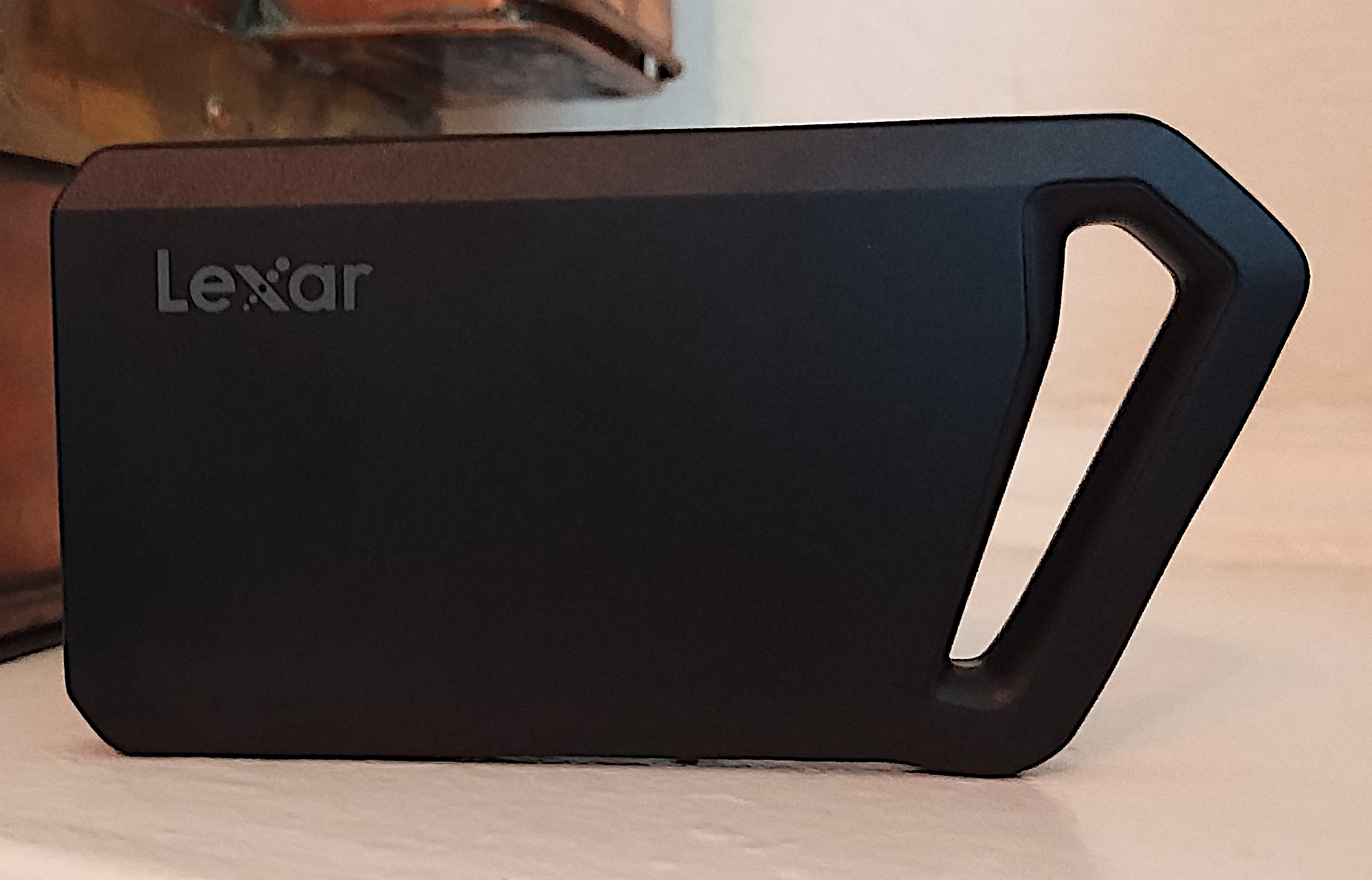
Pros
- Good 20Gbps performer
- Top bang for the buck
- Five-year warranty
Cons
- 4TB model not yet available
The competition is very close in the top tier of 20Gbps external drives, with the big name contenders trading wins up and down the benchmark charts. But a winner is a winner, and in the end, the Lexar overtook our previous champ, Crucial’s X10 Pro, even if only by a hair.
The upshot is that you can expect excellent performance from the Lexar SL600. It also comes in a uniquely shaped form factor, complete with an opening to accommodate a lanyard, for easy toting. Gamers might appreciate that you can even add some bling by opting for the SL660 variant, which features RGB lighting within its miniature handle. The drive comes with the standard five year warranty.
When performance is this closely matched among products, the determining factor should be price. And here, too, the SL600 is neck-and-neck with the Crucial X10 Pro, and priced slightly to significantly cheaper than some of its competitors, at least as of this writing — particularly at the 2TB level.
Seagate FireCuda Gaming SSD (1TB) – Best premium 20Gbps external SSD for gaming
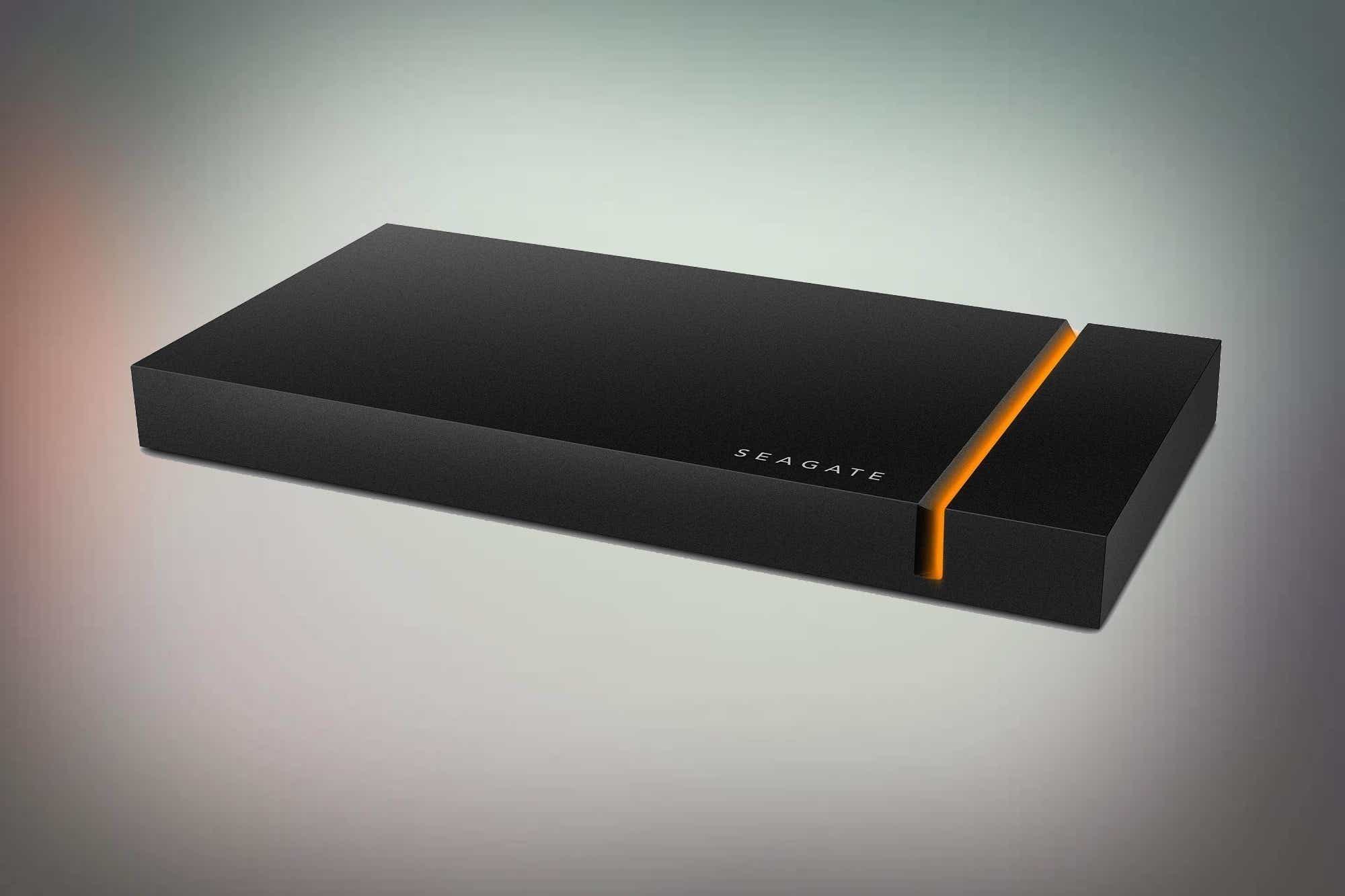
Pros
- Drop-dead gorgeous
- 2GBps transfers via SuperSpeed USB 20Gbps
Cons
- Pricey
- Superspeed USB 20Gbps ports are few and far between
Seagate’s FireCuda Gaming SSD is a worthy alternative, but it has a much steeper price tag for similar performance. However, the FireCuda is an absolutely stunning external SSD and is worthy of a place on any desktop. It’s not just a pretty façade though—it’s compatible with a SuperSpeed USB 20Gbps port, meaning it can attain transfer rates of up to 2GBps. It’s certainly the coolest-looking external SSD on this list.
Teamgroup M200 – Best budget 20Gbps external SSD for gaming
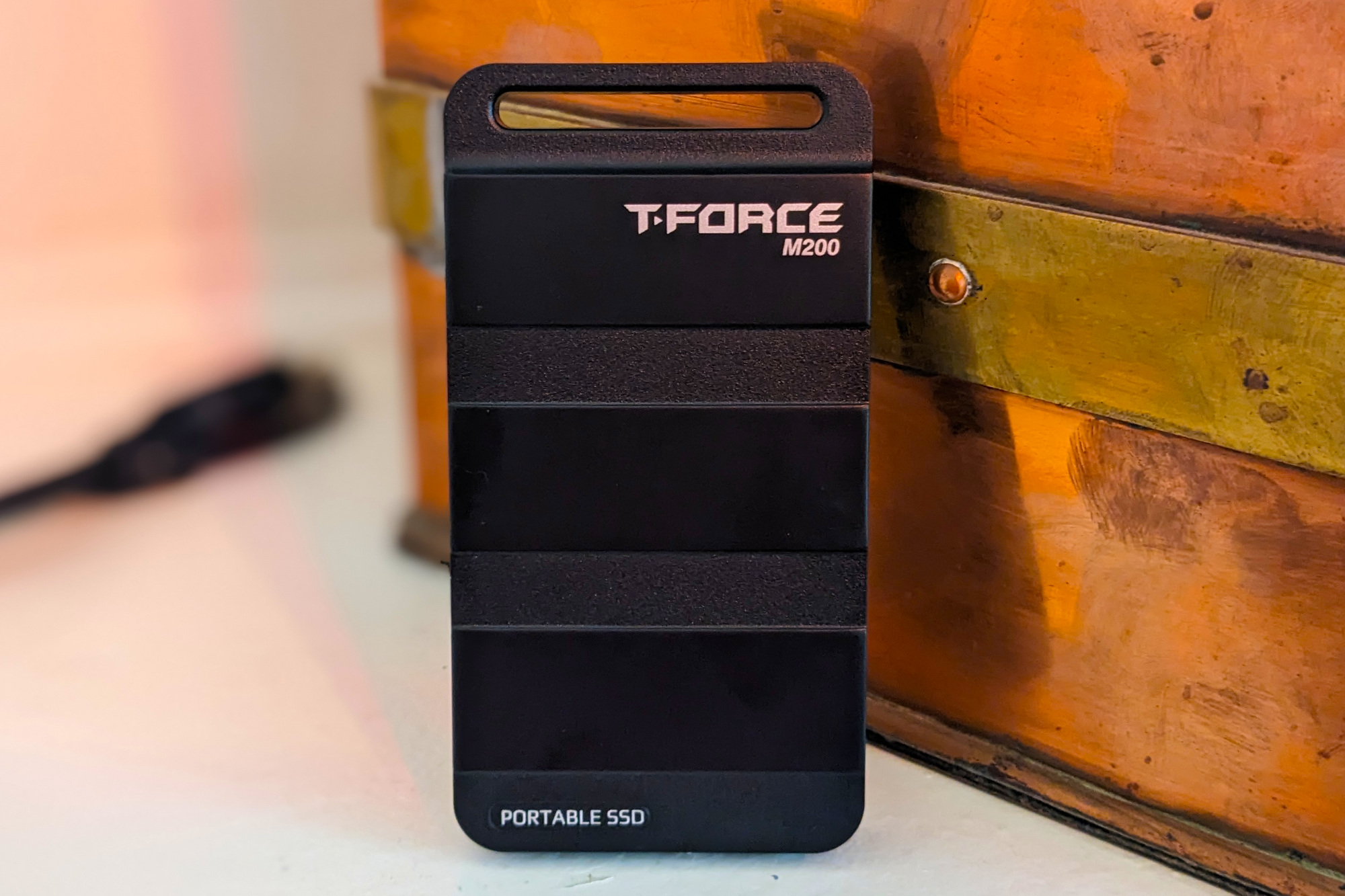
Pros
- Fast everyday performance
- Available in up to 8TB (eventually) capacity
- Attractively styled
Cons
- No TBW rating
- Company will change components if shortages demand
- Writes slow to 200MBps off cache
The Teamgroup M200 provides excellent bang for your buck with 20Gbps transfer rates and up to 4TB of storage for a very reasonable price. It has great everyday performance, too.
Its slick military-style design is based on the CheyTac M200 sniper rifle—a perfect fit for those late night frag sessions. Unfortunately, Teamgroup doesn’t provide a TBW rating or official IP rating for the M200 so it’s more difficult to compare it as a whole to its competitors. However the M200 is a fast, extremely well priced external SSD with a gamer-friendly design that will look good and perform well in almost any setup.
Sabrent Rocket Nano V2 – Most portable 20Gbps external SSD for gaming

Pros
- Extremely small profile
- Shock-absorbing silicone jacket
- Top-flight packaging
- Good overall performance
Cons
- A tad behind the 20Gbps curve performance-wise
If you’re after a very small SSD that you can easily fit into a pocket, the Sabrent Rocket Nano V2 is that. This USB 3.2×2 20Gbps drive measures a petite 2.73 inches long, 1.16-inches wide, and 0.44-inches thick. It weighs a dainty 1.7 ounces.
Of course, you’ll probably want to slide on its included shock-absorbing silicone jacket (shown in picture), which will add .06 inches to all its dimensions, while giving it a badass look.
But looks aside, the Nano V2 is a solid performer. It wasn’t quite at the same level as our top picks in everything, but it traded wins and losses within the pack. For instance it was second only to the Crucial X10 Pro in our 450GB write test. And it took the top spot in CrystalDiskMark 8’s random writes, and was very competitive in random reads.
This wee drive also comes in up to 4TB capacities, making it an all-around good choice if you’re looking to get a lot of storage and performance in a tiny package. We’re also fond of its five-year warranty and the nifty metal box it comes in, which can be repurposed for other uses.
OWC Express 1M2 SSD – Best USB 4 external SSD for gaming
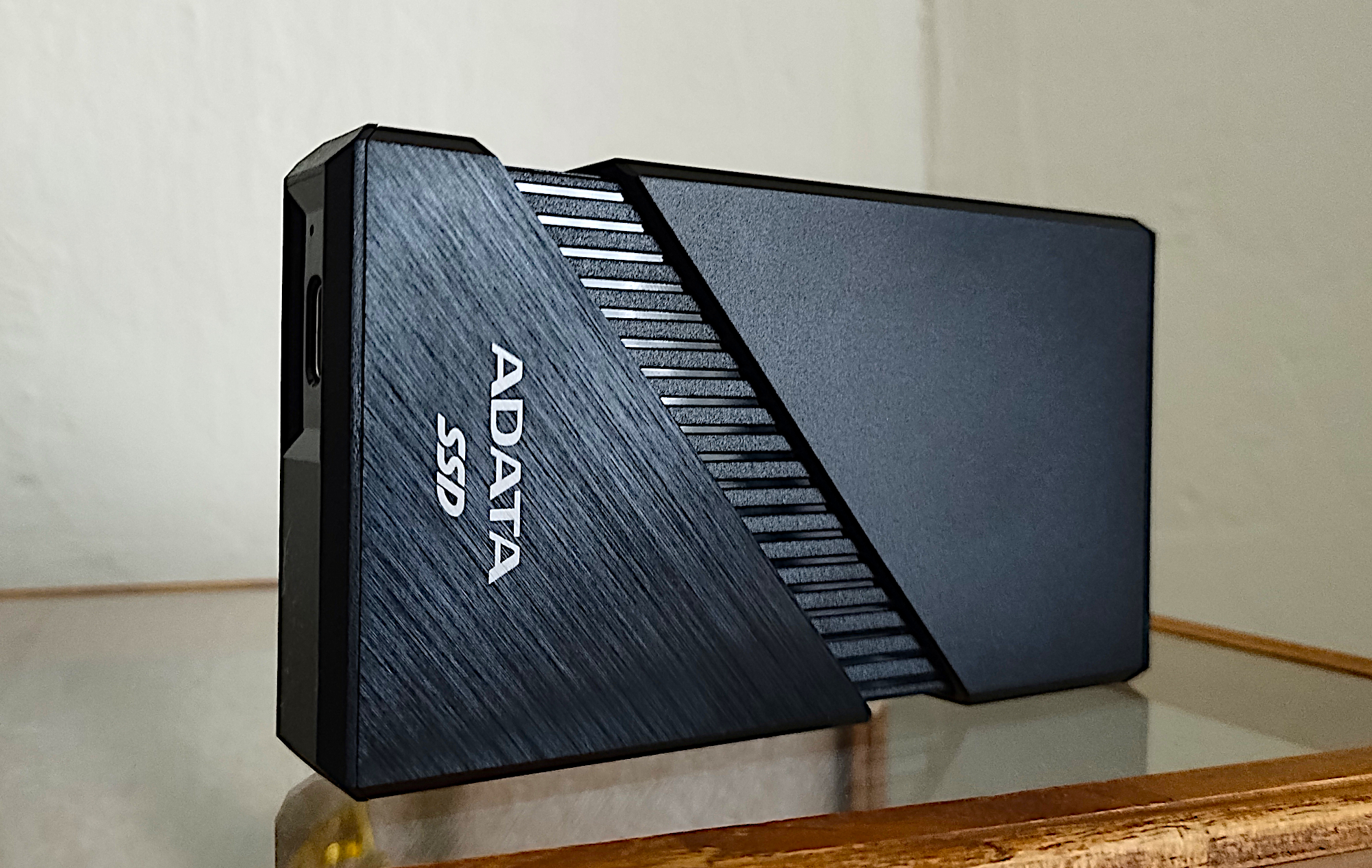
Pros
- Fastest external storage we’ve tested (at 40Gbps)
- Affordable for the ilk
- Stylish enclosure
- Available up to 4TB
- Also fast on the Mac
Cons
- Pricier than USB 3.2×2 (20Gbps)
A USB 4 external SSD isn’t for everyone. Not only does your PC need to support the spec in order to take advantage of the 40Gbps transfers, but you’ll also need to be willing to pay a premium for the privilege.
If you’re ready to enter the club, however, the Adata SE920 EX will reward you with the fastest USB 4 performance that we’ve experienced, and at a much more affordable price than our previous pick for USB 4, the OWC Express 1M2 — we’re talking $140 for a 1TB Adata SE920 versus $250 for the OWC drive. And if you want a lot of capacity, the Adata SE920 EX comes with up to 4TB, for a reasonable $380.
In almost every benchmark, the SE920 EX beat the OWC Express 1M2 at 40Gbps performance, albeit by small margins. It also comes with a nifty built-in fan, which is activated by sliding open the enclosure. This kept our drive noticeably free of heat during our benchmark tests.
The SE920 EX is also quite portable at 4.13 inches long by 2.52-inches wide by 0.62-inches thick, and weighing 7 ounces — another advantage it has over the bulkier OWC Express 1M2.
In the end, the choice for a USB 4 external SSD is clear.
How we test external SSD game performance
The biggest question you want to know is, how much does using an external drive hurt game performance. To give us an idea of how much it matters, we used UL’s new 3DMark Storage Benchmark. To create the benchmark, UL essentially records the drive access patterns during several common gaming tasks to make “traces.” These drive-access traces are then run on the tested storage device multiple times to duplicate the patterns without having to actually load the game.
For its test, 3DMark reproduces what happens loading to the start menus of Battlefield V, Call of Duty: Black Ops 4, and Overwatch. 3DMark Storage also tests using OBS, or Open Broadcast System, to record Overwatch being played at 1080p resolution at 60fps, installing The Outer Worlds from the Epic launcher, and saving a game in The Outer Worlds. For the final test, 3DMark Storage tests copying the Steam folder for Counter-Strike: Global Offensive from an external SSD to the target drive.
We used a 12th-gen Intel Core i9-12900K running Windows 11 on an Asus ROG Maximus Z690 Hero motherboard. The board features native Thunderbolt 4 and USB 3.2 10Gbps ports. We added a Silverstone ECU06 for USB 3.2 SuperSpeed 20Gbps support. We then used a Vantec M.2 NVMe SSD to USB 3.2 Gen2x2 20G Type C enclosure with a Western Digital SN700 NVMe SSD to test USB 3.2 20Gbps and 10Gbps performance. We also installed the same SN700 into a PCIe 3.0 riser card to test its native performance. This gives you an idea of how much you lose going from being installed inside the laptop or PC compared to using a USB port. For added contrast, we also ran 3DMark Storage on an older Plextor PX-512M7VG SATA SSD inside of a Silverstone MS09 SATA enclosure that was plugged into a USB 3.2 10Gbps port. And because you want to know how slow a hard drive would be, we also ran the same test on a Western Digital 14TB EasyStore hard drive plugged into a USB 3.2 10Gbps port. The EasyStore is actually limited to USB 3.2 SuperSpeed 5Gbps.
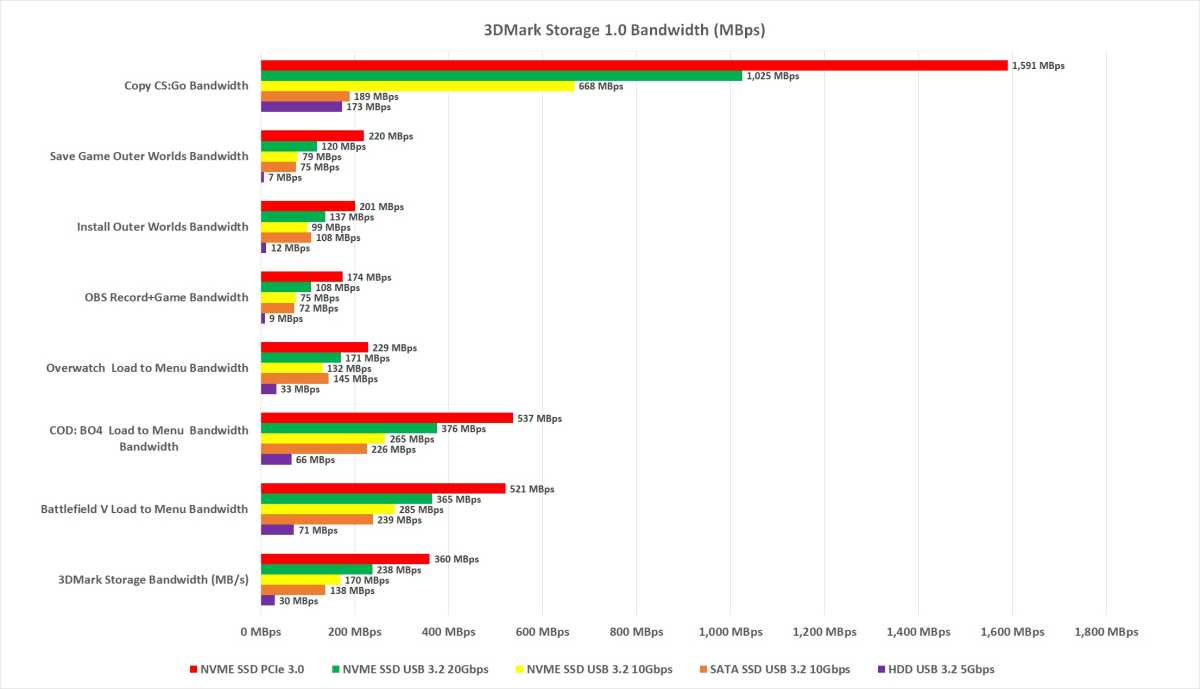
IDG
What should you make of the above results? Well, clearly if you can install an SSD inside of your PC, you’ll get the most performance out of it. But you should consider some of the context. If you’re only looking at the big long red bar at the top of the chart, consider that the particular test is measuring what would happen if you copied a large folder of files to the SSD. For most people, that’s only done once in a while.
The more common scenario is waiting for a game to launch. Running an internal NVMe drive will still be faster, but the gap closes a little. Between the three popular USB interfaces: USB 20Gbps, USB 10Gbps, and SATA on USB 10Gbps, the fastest is USB 3.2 20Gbps. With a USB 3.2 20Gbps SSD, you might see Battlefield V shave 25 percent of the load time versus a USB 3.2 10Gbps drive. Of course, performance is also game dependent. For instance, both Call of Duty and Battlefield see 45 percent or so greater bandwidth on the internal SSD, but with the less graphically intense Overwatch, it’s closer to 30 percent.
The other surprise is the performance of the SATA SSD versus the NVMe SSD when the NVMe SSD is in a USB 3.2 10Gbps port. In game loads, saves, and install scenarios, they’re fairly close. The NVMe external SSD does open up to huge lead over the slower SATA once you move to a task where you’re copying a huge amount of files—such as the CS:GO results. But again, how often do you do that?
Of course we can’t leave this without pointing out just horrible hard drives are. Would it be more improved with a faster hard drive? Unlikely. The very minimum you should use if storing games on an external drive is a SATA SSD, so don’t run a game from your external hard drive unless you like to wait for everything.


